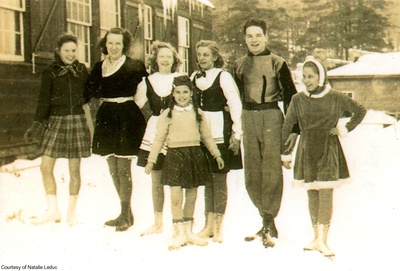 Skaters at the Curling Club, 1940. Bernadette Harrigan, Alice Walsh, unknown, Natalie Leduc, Phyllis Horton, John Walsh, Ruth Lamy. John Walsh was Sonja Henie's skating partner on professional tours.
Skaters at the Curling Club, 1940. Bernadette Harrigan, Alice Walsh, unknown, Natalie Leduc, Phyllis Horton, John Walsh, Ruth Lamy. John Walsh was Sonja Henie's skating partner on professional tours. 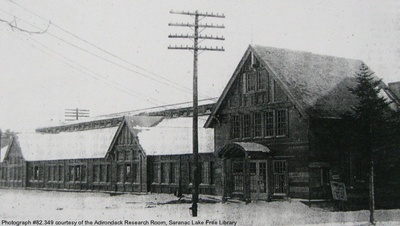 The Curling Rink, early 1900s, north of Pontiac Bay. Adirondack Daily Enterprise, February 21, 2004
The Curling Rink, early 1900s, north of Pontiac Bay. Adirondack Daily Enterprise, February 21, 2004  The Saranac Lake Curling Club is seen in action on the two ice sheets of its own rink. This club combined the Pontiac Bay Curling Club and the Pines Curling Club, which formerly played on Moody Pond, in a new indoor rink built in 1918 by Walter Cluett This structure was located between River Street and the bleachers that faced the skating rink on Pontiac Bay, with the sheets roughly parallel to the street. The two structures together nearly completely filled the narrow area of today's park land to the left of modern ice palaces, as seen from the street. To their right was the Boys' Club building that later became the Armory. A new, four-sheet curling rink was built in 1931, in time to host the Gordon International competition between Canada and the U.S. in association with the Olympic Winter Games in Lake Placid. That rink is now Madden's storage building. This old rink became Al Shortt's garage, and was later torn down. (undated) Adirondack Daily Enterprise, March 9, 2013.
The Saranac Lake Curling Club is seen in action on the two ice sheets of its own rink. This club combined the Pontiac Bay Curling Club and the Pines Curling Club, which formerly played on Moody Pond, in a new indoor rink built in 1918 by Walter Cluett This structure was located between River Street and the bleachers that faced the skating rink on Pontiac Bay, with the sheets roughly parallel to the street. The two structures together nearly completely filled the narrow area of today's park land to the left of modern ice palaces, as seen from the street. To their right was the Boys' Club building that later became the Armory. A new, four-sheet curling rink was built in 1931, in time to host the Gordon International competition between Canada and the U.S. in association with the Olympic Winter Games in Lake Placid. That rink is now Madden's storage building. This old rink became Al Shortt's garage, and was later torn down. (undated) Adirondack Daily Enterprise, March 9, 2013. 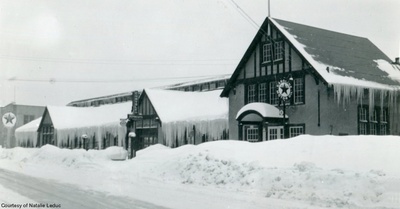 Al Shortt's Lakeside Garage, undated Curling started in Saranac Lake in 1897. Two clubs formed were formed, the Pontiac Bay Curling Club and the Pines Curling Club; these combined to form the Saranac Lake Curling Club.
Al Shortt's Lakeside Garage, undated Curling started in Saranac Lake in 1897. Two clubs formed were formed, the Pontiac Bay Curling Club and the Pines Curling Club; these combined to form the Saranac Lake Curling Club.
The Saranac Lake Curling Club was based in a curling rink built for the village in 1918 by Walter Cluett, and replaced in 1931 by a larger concrete building with a unique Lamella roof, again designed by William G. Distin. The original rink was located directly behind the bleachers of the Pontiac Bay skating rink; on its other side was the Boys' Club building. After the new rink was built, the old rink became Al Short's Garage.
Later, the skating rink was moved to the athletic fields beside the new Petrova School, and the Boys Club building was taken over by the State for use as an Armory (though it continued to be used as a gymnasium by St. Bernard's School). After the New National Guard Armory was built on the Lapan Highway, North Country Community College used the old building as a gymnasium. When River Street was rebuilt and the state boat launch created nearby, all of the buildings between River Street and Lake Flower were removed. 1
Firgure skating lessons were offered at the Curling Club in the 1940s.
The Curling Club closed in 1943, due to war-time economic conditions; the 1931 curling rink is used by Maddens Transfer and Storage.
Curling returned to the Winter Carnival in 2005. 2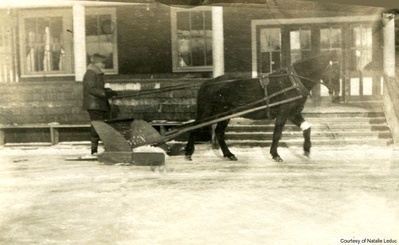 Before the Zamboni: cleaning the ice
Before the Zamboni: cleaning the ice
Plattsburgh Sentinel, February 7, 1922
The Saranac Lake Curling Club have had a very successful season so far this year and have already won the Gordon Medal at Schenectady, and the Allen Medal at Utica. They have also retained the possession of the Dr. Robert C. Paterson Cup in Saranac.
Lake Placid News, February 8, 1924
Patterson Trophy Stays With Saranac Curlers
For the third successive year, Saranac Lake curlers retained possession of the Patterson Memorial trophy, competition for which was held at the Saranac Lake curling club on Monday. In the final round, the first and second teams of Saranac Lake faced each other, with the former coming out victorious by an 18 to 12 score.
The first Saranac Lake team, composed of A. H. Denny, first; Dr. Sydney F. Blanchett, second; Dr. C. C. Trembley, third; and T. P. Smith, skip, reached its final bracket in rather easy style. After taking the measure of the Brookline club, 14 to 6, in the opening round, the winners defeated Jersey City, 20 to 10, in the semi-final. Jersey City had previously defeated the Sno Birds of Lake Placid Club, 12 to 7. Saranac Lake's second squad, made up of William G. Distin, first; John A. Gallaway, second; Ralph B. Leonard, third, and Stanley J. Appleyard, skip, did not have such an easy time. In the preliminary match, they defeated Schenectady, 24 to 7, but in the semi-finals just nosed out a victory over Utica by a 19 to 17 score. Utica won its preliminary match by beating the Pines club of Saranac Lake, 10 to 9.
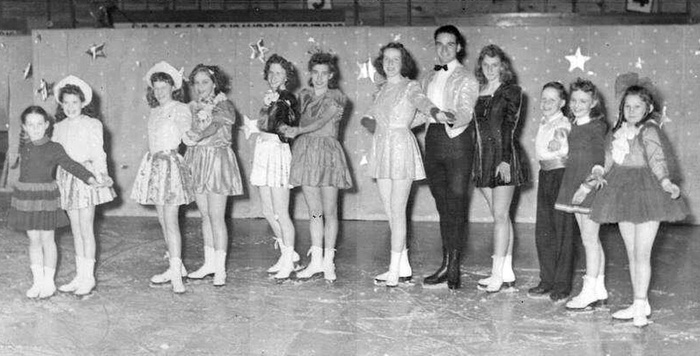 An ice show at the Curling Club, c. 1940. Left to right: Phyllis Krinovitz (Feinberg), Natalie Bombard (Leduc), Pat Smith, Ruth Lamy, Bernadette Harrigan, Helen Rankin, Alice Walsh Kennedy, John Walsh, Phyllis Horton, Bob Walsh, Jewel Smith, Phyllis McKillip.
An ice show at the Curling Club, c. 1940. Left to right: Phyllis Krinovitz (Feinberg), Natalie Bombard (Leduc), Pat Smith, Ruth Lamy, Bernadette Harrigan, Helen Rankin, Alice Walsh Kennedy, John Walsh, Phyllis Horton, Bob Walsh, Jewel Smith, Phyllis McKillip.
Courtesy of Natalie LeducFrom the New York: A Guide to the Empire State, By the Federal Writers' Project of the Works Progress Administration, 1940, Oxford University Press, p. 508
The CLUBHOUSE OF THE SARANAC LAKE CURLING CLUB, 123 Beaver St.,[sic] built in 1930 to replace its outgrown predecessor, is equipped with six ice sheets, a skating rink, and a heated spectators' balcony. Teams from eastern Canada and the United States compete here annually for the Patterson [sic: Paterson] Memorial Trophy and the Mitchel Medal; the Gordon International Curling Match, the outstanding event in the sport, was played here in connection with the winter Olympics in 1932. 3 With the growth of interest in winter sports, this national game of Scotland, which is much like bowling on ice, is spreading in the United States and Canada. The origin of the game is uncertain, but for more than three centuries it has been played in Scotland, where the Grand Caledonian Curling Club, established in 1838, formulated the rules that now govern the game.
Lake Placid News, December 8, 1933
To Have Indoor Skating Rink at Saranac Lake
An indoor skating rink for Saranac Lake will be made available by the Curling club, according to announcement by Dr. Sidney F. Blanchet Sunday following a meeting of the club directors.
The skating rink will encircle the curling rinks at the club house in River street, providing a maximum of comfort and assurance of good skating conditions for the bladsters. At the same time the center rinks of the curlers may be used by devotees of the ancient Scottish game.
Memberships of skaters are to be arranged by a new committee. The tentative plans call for family as well as individual memberships. Non-members will also be permitted to use the skating rinks.
It is expected that the skating rinks will be ready for use in about two weeks. A caretaker and instructor will be in attendance.
Adirondack Daily Enterprise, Page 6, March 30, 1953
By BILL DISTIN
About 1912 or 13, Tommy Smith, who had been a crack Canadian curler, got a few of us interested in the game and we made a start on outdoor ice at the Gun Club on Moody Pond. Our enthusiasm soon brought others to join the club and we had a lot of fun learning. The rink was then moved to the Pontiac Bay but this did not work out as skaters were attracted to the fine ice of the curling rink and this ruined it for play. The next move was to ice adjoining the Armory and then to two sheets of ice to the rear of the present Woolworth store. This rink was protected by a tar paper roof on open posts and our first experience of curling under cover. The first curling in Scotland and then on this side of the Atlantic was done on open ice, subject to cracks, heaving, soft spots, etc., and many a roaring match was played under these conditions. Curling today, however, is a different game and demands a perfect sheet of carefully pebbled ice, with the result that all modern rinks are covered and in most cases have artificial ice.
Our club finally joined the Grand National and in due time we sent our first team to Utica to compete in a national bonspiel [tournament]. This team, composed of Tommy Smith, Dr. Robert Paterson, Walter Cluett and the writer, surprised themselves (and others) by winning the much coveted Mitchell Medal. Walter Cluett was so enthusiastic that he offered to build a rink in Saranac Lake if we could sign up forty members for the club. So the building next to the Armory (recently destroyed by fire) was erected and for several years curling was done in comfort. These two sheets of ice did not meet the demands of the growing club so that building was sold and another building with four sheets of ice was built, with a comfortable club room, kitchen, etc. Annual bonspiels were held which attracted teams from this country and Canada and, with these and nightly local matches, the place was a bee-hive of activity.
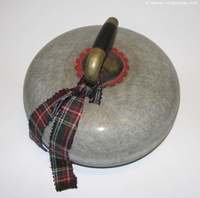 The curling stone of Dr. Charles Trembley
The curling stone of Dr. Charles Trembley
Then came the war and depression, membership fell off and we were not able to continue. Taxes on the property were very high and efforts were made to have these reduced or eliminated entirely, but to no avail. It is the opinion of many that the Village should have taken over this property because curling brought many outsiders to Saranac Lake and today it would be an added attraction from an advertising standpoint.
Of late years, some of the members have curled each Winter in other places and this Winter a team was entered in the first Annual Bonspiel of the Lake Placid Club Sno Birds. Eighteen teams were entered from this country and Canada and our local team won two and lost two games. Not bad, considering the fact that we had curled but little in a number a years.
Space does not permit the mention of all the original members of the club but a few who were very active in addition to those mentioned above were Dr. Sidney Blanchet, Dr. Robert Brown, Louis Kernochan, W. L. Distin, Floyd Green, Dr. Charles Trembley, Ralph Leonard, Harry Danforth, John Hogan, Laird Snowden and Herbert Leggett. There were many others but the list is too long for this space.
Curling is played in almost every city and village in Canada and many clubs are spread through the east and central portion of this country and the popularity of the game is spreading. Saranac Lake is being continually urged to rejuvenate the game here and there are many here who would like to see this interesting sport brought to life in our Village. There are enough men and women here to make a strong club and I hope something can be done about it.
From pages 21, 23 & 25, "Saranac Lake in the Adirondacks: The Gateway to the Olympics, 1932," reprinted as a supplement to the Adirondack Daily Enterprise, February 15, 2014.
Curling Club
Continuing an eighth of a mile fu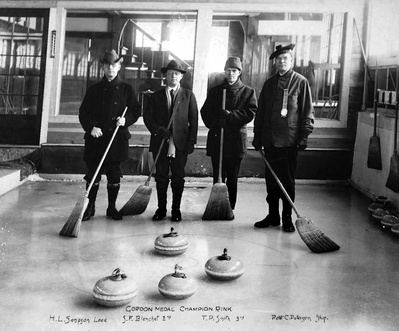 Gordon Medal Champion Rink. Homer Sampson, lead, Dr. Sidney Blanchet, 2nd, Tommy Smith, 3rd, Robert C. Paterson, Skip.
Gordon Medal Champion Rink. Homer Sampson, lead, Dr. Sidney Blanchet, 2nd, Tommy Smith, 3rd, Robert C. Paterson, Skip.
Courtesy of Sarah Blanchet.rther east and along River Street brings one to the Saranac Lake Curling Club, whose new building was opened in 1931 at a cost of $40,000. The four "rinks" or sheets of ice make it possible for thirty-two persons to play at one time. On February 5th and 6th, 1932, the matches for the Gordon International Championship Medal will be held here, bringing together most of the best curlers from the United States and Canada.
This Club was one of the results of a committee for winter sports formed in 1912 by Seaver A. Miller and Dr. Sidney F. Blanchet, respectively, President and Secretary of the (then) Saranac Lake Board of Trade. On this committee were H. E. Fraleigh, Stephen Chalmers, W. G. Distin, J. J. O'Connell and S. F. Blanchet, chairman.
In the early part of 1913 a curling rink and toboggan slide were started, curling-irons being secured from Montreal and a "rink" laid out on the Moody lot at the side of the Boys' Club. With Thomas P. Smith, an expert curler from Ormston, Quebec, the game gained great favor; the first season's membership of about 35 was drawn from the leading business and professional men of the village. The following year a two-rink sheet of ice was arranged on the McKee lot back of the old Post Office; the fact of its being covered and centrally-located brought new members.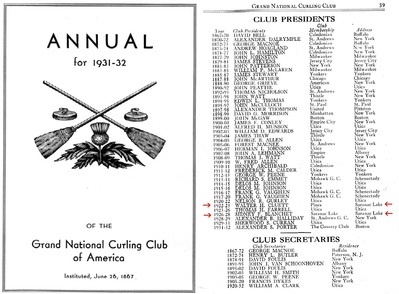 Saranac Lake Curling Club members headed the National Curling Club of America twice - Walter Cluett in 1922 and Dr. Sidney Blanchet in 1926.
Saranac Lake Curling Club members headed the National Curling Club of America twice - Walter Cluett in 1922 and Dr. Sidney Blanchet in 1926.
During the first year or two the sports committee functioned as officers of the club, but in 1915 W. G. Distin was elected President; Louis Kernochan, Vice-President; W. L. Hoag, Secretary-Treasurer.
In 1918 Walter H. Cluett offered to give a new building. This generous proposition was accepted and an attractive structure erected on River Street in the summer of that year, and used for the season of 1918-1919 for the first time. The club had joined the National Curling Association in 1917, since which time teams have been sent each year to compete at Schenectady and Utica.
The present officers are H. R. Leggett, President; Wm. H. Scopes, 1st Vice-President; C. F. Roberson, 2nd Vice-President; Robert Smith, Secretary; S. J. Appleyard, Treasurer; A. H. Denny, Recording Secretary.
Comments
Footnotes
1. John Duquette, Adirondack Daily Enterprise, Weekender, September 2, 1995, p. 2
2. Adirondack Daily Enterprise Weekender, February 4, 2005, pp. 3-40
3. From So This Is Curling by Ruth Howe, p. 14: The Grand National Curling Club of America was formed in 1868. Robert Gordon, its first patron, sponsored the Gordon Rink Medal (1868) and the Gordon International Medal (1884). "The Gordon International Medal was given to curlers of the United States and Canada 'to be played for at Montreal and the United States alternately under the direction of the officers of the Canadian Branch of the Royal Caledonian Curling.' This medal is so highly valued that it is kept in a safety deposit box except during the four days of international competition.'"



